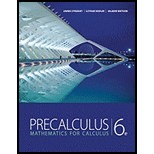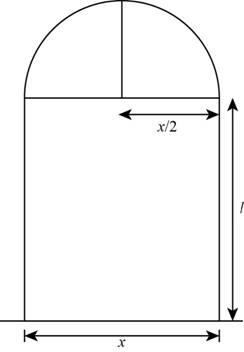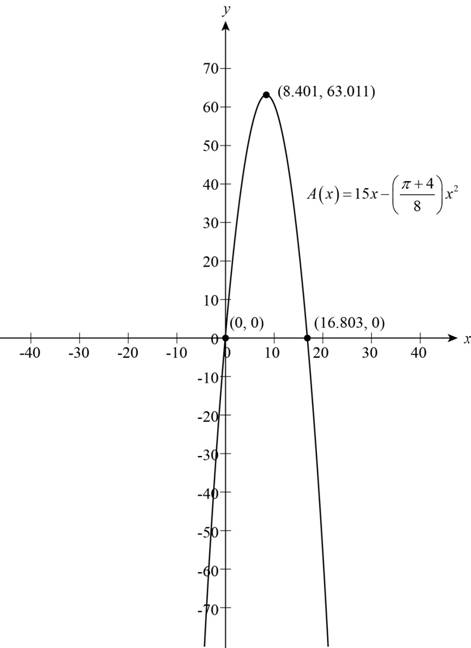
Concept explainers
Light from a Window A Norman window has the shape of a rectangle surmounted by a semicircle, as shown in the figure to the left. A Norman window with perimeter 30 ft is to be constructed.
- (a) Find a function that models the area of the window.
- (b) Find the dimensions of the window that admits the greatest amount of light.
(a)
To find: The function that models the area of the window.
Answer to Problem 25P
The function that models the area of the window is
Explanation of Solution
Given:
A Norman window is in the shape of the rectangle with perimeter

Figure (1)
Formula used:
The area of the rectangle is,
Perimeter of the rectangle is,
The area of the semi circle is,
Perimeter of the semi circle is,
Calculation:
Let the length in the Norman window is l units and the radius of the semicircle is r units.
The Norman window with the radius of the semicircle and the length of the rectangle is shown below.

Figure (2)
The radius of the semicircle is,
The perimeter of the Norman window is,
Substitute
Further solve the equation,
The length of the window is
The area of the Norman window is,
Substitute
Further solve the above equation,
Thus, the function that models the area of the window is
(b)
To find: The dimension of the window that admits the greatest light.
Answer to Problem 25P
The width of the Norman window is
Explanation of Solution
From the part(a), the function that models the area of the window is
To find the dimension that admits the greatest amount of light, it needs to draw the graph of the function
The function contains the variable x is the breadth of the rectangular portion of the window.
The local maximum value of the function is the maximum finite value where the value of the function at the any number is greater than to the original function.
The condition for local minimum is,
The graph of the function is shown below,

Figure (3)
From the graph of the function shown as Figure (3) the greatest peak of the graph at the point
Then the maximum light admit from the Norman window is
Substitute 8.4 for x in the length
The length of the window is
Thus, the width of the Norman window is
Chapter 2 Solutions
EBK PRECALCULUS: MATHEMATICS FOR CALCUL
- Use Euler's method to numerically integrate dy dx -2x+12x² - 20x +8.5 from x=0 to x=4 with a step size of 0.5. The initial condition at x=0 is y=1. Recall that the exact solution is given by y = -0.5x+4x³- 10x² + 8.5x+1arrow_forwardFind an equation of the line tangent to the graph of f(x) = (5x-9)(x+4) at (2,6).arrow_forwardFind the point on the graph of the given function at which the slope of the tangent line is the given slope. 2 f(x)=8x²+4x-7; slope of the tangent line = -3arrow_forward
- please dont use chat gptarrow_forwardQuestion Given the graph of f(z) below, identify the graph of f'(z). Select the correct answer below: -7-6-5-4-3-2 1 2 3 4 5 6 + 123. -7-6-5-4-3 12 + 4-3-2-1 1arrow_forwardFind this expression in frequency domain in a expression y(t), in time, that is.arrow_forward
- please dont use chat gptarrow_forwardQuestion Given the graph of f(z) below, find the graph of the derivative of f(z). Select the correct answer below: ° 7-6-5-4-3 123 ° ° 2 -7-6-5-4-3- 123 -° 2-4 -°- °- -7-6-5-4-3-2-1 1 5 +arrow_forwardWhich of the functions shown below is differentiable at = 0? Select the correct answer below: -7-6-5-4- -6-5-4-3-21, -7-6-5-4-3-2 -7-6-5-4-3-2-1 2 4 5 6 -1arrow_forward
 Calculus: Early TranscendentalsCalculusISBN:9781285741550Author:James StewartPublisher:Cengage Learning
Calculus: Early TranscendentalsCalculusISBN:9781285741550Author:James StewartPublisher:Cengage Learning Thomas' Calculus (14th Edition)CalculusISBN:9780134438986Author:Joel R. Hass, Christopher E. Heil, Maurice D. WeirPublisher:PEARSON
Thomas' Calculus (14th Edition)CalculusISBN:9780134438986Author:Joel R. Hass, Christopher E. Heil, Maurice D. WeirPublisher:PEARSON Calculus: Early Transcendentals (3rd Edition)CalculusISBN:9780134763644Author:William L. Briggs, Lyle Cochran, Bernard Gillett, Eric SchulzPublisher:PEARSON
Calculus: Early Transcendentals (3rd Edition)CalculusISBN:9780134763644Author:William L. Briggs, Lyle Cochran, Bernard Gillett, Eric SchulzPublisher:PEARSON Calculus: Early TranscendentalsCalculusISBN:9781319050740Author:Jon Rogawski, Colin Adams, Robert FranzosaPublisher:W. H. Freeman
Calculus: Early TranscendentalsCalculusISBN:9781319050740Author:Jon Rogawski, Colin Adams, Robert FranzosaPublisher:W. H. Freeman
 Calculus: Early Transcendental FunctionsCalculusISBN:9781337552516Author:Ron Larson, Bruce H. EdwardsPublisher:Cengage Learning
Calculus: Early Transcendental FunctionsCalculusISBN:9781337552516Author:Ron Larson, Bruce H. EdwardsPublisher:Cengage Learning





